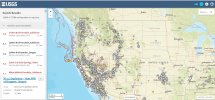Recently I stumbled upon the following study:
"Towards a theoretical determination of the geographical probability distribution of meteoroid impacts on Earth"
https://arxiv.org/abs/1801.05720
Here are some points from the paper, but perhaps others can go over it and analyze it better.
https://arxiv.org/pdf/1801.05720.pdf
Also, perhaps totally unrelated, but the mention of specific time of impacts reminded me about something else. There is the following interview of John Keel by David Letterman, where he mentions "sky quakes" (starting from 1:30 min). Apparently they happen every January and February in the North East of US. Their description os very similar to an overhead explosion, but the repeated pattern what cofuses the matter. But maybe not?
https://youtu.be/KC5f9OYSRa8
"Towards a theoretical determination of the geographical probability distribution of meteoroid impacts on Earth"
https://arxiv.org/abs/1801.05720
Tunguska and Chelyabinsk impact events occurred inside a geographical area of only 3.4\% of the Earth's surface. Although two events hardly constitute a statistically demonstration of a geographical pattern of impacts, their spatial coincidence is at least tantalizing. To understand if this concurrence reflects an underlying geographical and/or temporal pattern, we must aim at predicting the spatio-temporal distribution of meteoroid impacts on Earth. For this purpose we designed, implemented and tested a novel numerical technique, the "Gravitational Ray Tracing" (GRT) designed to compute the relative impact probability (RIP) on the surface of any planet.
GRT is inspired by the so-called ray-casting techniques used to render realistic images of complex 3D scenes. In this paper we describe the method and the results of testing it at the time of large impact events. Our findings suggest a non-trivial pattern of impact probabilities at any given time on Earth. Locations at 60−90deg from the apex are more prone to impacts, especially at midnight. Counterintuitively, sites close to apex direction has the lowest RIP, while in the antapex RIP are slightly larger than average. We present here preliminary maps of RIP at the time of Tunguska and Chelyabinsk events and found no evidence of a spatial or temporal pattern, suggesting that their coincidence was fortuitous. We apply the GRT method to compute theoretical RIP at the location and time of 394 large fireballs. Although the predicted spatio-temporal impact distribution matches marginally the observed events, we successfully predict their impact speed distribution.
Here are some points from the paper, but perhaps others can go over it and analyze it better.
https://arxiv.org/pdf/1801.05720.pdf
This paper begins by raising the question of why the Chelyabinsk and Tunguska events happened just 2,400 km apart. Although we did not find a definitive answer to this “puzzle” (if there is actually one), several interesting facts arose during our investigation. The first one is that at the latitude where both events happened φ ∼ 60◦ , the apex colatitude varies during the year between θ geo apex ∼ 30◦ and θ geo apex ∼ 150◦ .
We expect that during the greater part of the day, both Tunguska and Chelyabinsk regions are at apex colatitudes where large impact probabilities exist. But this condition is not restricted to those sites. In the northern hemisphere Norway, Canada and Alaska, are in continental areas with similar latitudes. In the southern hemisphere, however, geographical locations with similar conditions are in the middle of the ocean (Indian, Altantic and Pacific). Another interesting common condition between the Tunguska and Chelyabinsk regions at the date and time of the impacts is that both happen around the same universal time (0 − 3 UTC). Accordingly, both sites were around the same geographical hemisphere as the apex (see maps in Figure 9 and Figure 10) and above the apex equator. These are precisely the regions where according to GRT the largest probabilities are found.
We confirmed our initial hypothesis that at a given time not all points on Earth are equally prone to impacts (geographical instantaneous distribution is not uniform). Geographical areas pointing in the same direction of the apex projection on Earth’s surface (geographic apex) have lower impact probabilities than those located in the anteapex direction. The largest probabilities predicted by our method are however, localized on extensive geographical areas around to geographic apex equator (locations located in directions perpendicular to the apex-antapex direction).
No obvious relationship among the geographical areas of the Chelyabinsk and Tunguska events were discovered with GRT. However, several interesting common features of their locations were identified. Chelyabinsk and Tunguska areas are located during most part of the year at low apex latitudes (large geographic apex colatitudes), where impact fluxes are larger. Moreover, the impact events at both sites, happened around the same time of the day and the AM/PM asymmetry could increase the chances for an impact on these locations.
Also, perhaps totally unrelated, but the mention of specific time of impacts reminded me about something else. There is the following interview of John Keel by David Letterman, where he mentions "sky quakes" (starting from 1:30 min). Apparently they happen every January and February in the North East of US. Their description os very similar to an overhead explosion, but the repeated pattern what cofuses the matter. But maybe not?
https://youtu.be/KC5f9OYSRa8

